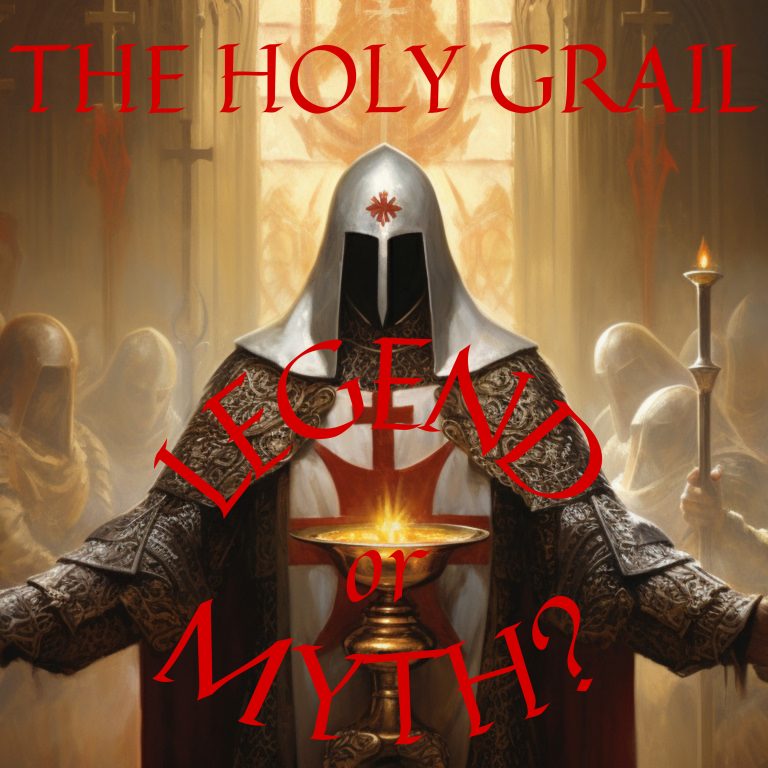
This show will get to the bottom of all those questions you need answers to. Each week, we will cover a topic that has been left unattended in the public square, with unanswered questions surrounding the “official story.” You will be able to determine on this show if the topic has been deemed a “Conspiracy” or a “Conspiracy Theory”.
If you want to support the show, you can become a subscriber and get access to bonus content. Click here to support https://creators.spotify.com/pod/profile/bottomofthat/subscribe
The Holy Grail, a legendary and elusive artifact of great cultural and spiritual significance, has intrigued humanity for centuries. Today's show will aim to provide a comprehensive exploration of the Holy Grail, traversing historical, literary, and cultural contexts. By examining its origins in medieval literature, its integration into religious narratives, and its enduring impact on popular culture, this paper seeks to unravel the layers of mystery surrounding the Holy Grail and its symbolic significance. It is also an iconic and legendary artifact that features prominently in various historical and mythological narratives, especially those related to Christian and Arthurian traditions.
Website – http://www.bottomofthat.com
Instagram – @bottomofthat
https://www.instagram.com/bottomofthat
Facebook – @bottomofthat
https://www.facebook.com/bottomofthat
X – @bottomofthat
https://twitter.com/bottomofthat
TikTok – @bottomofthat
https://www.tiktok.com/@bottomofthat
Email – truth@bottomofthat.com

The Holy Grail :
is an iconic and legendary artifact that features prominently in various historical and mythological narratives, especially those related to Christian and Arthurian traditions. Its exact nature and symbolism can vary, but here are some key aspects:

- Christian Significance: In Christian tradition, the Holy Grail is often described as the cup or chalice used by Jesus at the Last Supper and, in some accounts, used to catch his blood at the Crucifixion. It symbolizes the quest for spiritual enlightenment and the divine.Arthurian Legend: In Arthurian legends, the Holy Grail is a central object of quest. It’s sought by the Knights of the Round Table, often in a quest that tests their purity and worthiness. The most famous story is the quest for the Grail by Sir Galahad, Sir Percival, and Sir Bors
- Origins in Arthurian Legend: The Holy Grail first appears in Arthurian stories in the late 12th century, with Chrétien de Troyes’ “Perceval, the Story of the Grail”. It was later expanded upon in works like Robert de Boron’s “Joseph d’Arimathie” and the Vulgate Cycle, a series of Old French texts.
- Nature of the Grail: In these legends, the Grail is often depicted as a miraculous object with divine properties. It is sometimes presented as a chalice, a dish, or even a stone. The Grail’s nature can vary, but it is consistently shown as a symbol of divine grace and a source of miracles.
- Quest for the Grail: The Grail Quest is a central theme in Arthurian tales. It is often portrayed as a spiritual journey, requiring purity of heart and soul. The quest is undertaken by various knights, including famous figures like Sir Lancelot, Sir Percival, and Sir Galahad. Each knight’s quest reflects their personal journey towards spiritual enlightenment.
- Sir Galahad: Galahad, the illegitimate son of Sir Lancelot, is often depicted as the purest and most worthy of the knights, and in many stories, he is the one who ultimately finds the Grail. His success is attributed to his purity and spiritual perfection.
- Symbolism and Themes: The Grail quest in Arthurian legend is rich in symbolism. It represents the pursuit of ultimate truth and the struggle of human beings to achieve spiritual perfection. The difficulty of finding the Grail underscores the idea that spiritual enlightenment is a challenging, often unattainable goal.
- Impact on Medieval Literature: The Grail stories had a significant impact on medieval literature and Christian symbolism. They blended Christian themes with the adventurous spirit of knightly quests, creating a rich tapestry of chivalry, moral challenges, and spiritual quests.
- Continued Influence: The influence of the Grail in Arthurian legend extends to modern times, inspiring countless adaptations and interpretations in literature, film, and other media. The Grail quest motif is often used as a metaphor for personal enlightenment and the pursuit of an ultimate goal.
- In summary, the Holy Grail in Arthurian legend is much more than a mere object; it’s a symbol of divine grace, a goal of spiritual quest, and a narrative device that explores themes of purity, worthiness, and the human pursuit of the divine.
- Historical Context and Variations: The concept of the Holy Grail has been adapted and reinterpreted in various cultures and periods. It has been linked to Celtic mythology, medieval Christian mysticism, and even the concept of the philosopher’s stone in alchemical traditions.
The historical context of the Holy Grail is a fascinating blend of early Christian history, medieval legend, and evolving cultural symbolism. Here’s a closer look:- Early Christian Influence: The origins of the Holy Grail are closely linked to Christian traditions. The idea of a sacred vessel associated with Jesus Christ’s Last Supper and the Crucifixion suggests early Christian influences, especially in the context of the Eucharist, where the chalice holds significant religious symbolism.
- Medieval Developments: The Holy Grail entered popular European lore in the Middle Ages, particularly through medieval romances like those of Chrétien de Troyes and later the Vulgate Cycle. These works combined Christian elements with Celtic myths and the chivalric codes of the era, creating a rich tapestry that was both spiritual and adventurous.
- Celtic and Pagan Origins: Some scholars believe that the Grail legends may have been influenced by earlier Celtic mythology and pagan traditions. Elements like the cauldron of abundance and magical vessels in these myths might have merged with Christian symbolism to form the Grail legend.
- Celtic Mythology: One of the most significant potential influences on the Grail legend comes from Celtic mythology. Celtic tales often featured magical cauldrons or cups with special powers. For example, the Cauldron of Dagda from Irish mythology was said to restore the dead to life, similar to the life-giving and restorative properties later attributed to the Grail in Christian narratives.
- Fisher King and Wasteland: Another notable element is the story of the Fisher King, which parallels the Grail legend in Arthurian tales. The Fisher King, who guards the Grail, is wounded, causing his land to become a barren wasteland. This motif resembles themes in Celtic legends where the health of the land is directly tied to the well-being of its king, a concept known as the Sovereignty goddess.
- Transformation and Rebirth: The theme of transformation and rebirth, central to many pagan traditions, is also a key aspect of the Grail legend. The Grail’s ability to heal and rejuvenate reflects older beliefs in the cyclical nature of life and the regenerative powers of the earth.
- Vessels of Abundance: The Grail is often associated with abundance and sustenance, a theme common in various pagan traditions. For instance, the Cornucopia or “Horn of Plenty” in Greek mythology and the cauldrons of abundance in Celtic lore are similar in their symbolic roles as providers of unending nourishment or wealth.
- Integration into Christian Narrative: As Christianity spread across Europe, it was common for pre-existing pagan beliefs and symbols to be integrated into Christian narratives. The Holy Grail may represent such a synthesis, combining the Christian symbolism of the chalice used at the Last Supper with the pagan imagery of magical vessels.
- Gnostic and Hermetic Influences: Some scholars suggest that Gnostic and Hermetic traditions, which predate and existed alongside early Christianity, may have also influenced the Grail legend. These esoteric traditions emphasized personal spiritual knowledge and enlightenment, akin to the quest for the Grail in later Arthurian tales.
- Variability in Medieval Literature: It’s important to note that medieval Grail literature does not present a single, unified narrative. Different stories offer various interpretations of the Grail, reflecting a melding of diverse cultural and religious traditions, including pagan elements.
- Quest for Relics: The Middle Ages saw a significant interest in religious relics, with various objects claimed to have holy significance. This period’s fascination with relics likely fueled interest in the Grail as a tangible, sought-after religious object.
- Alchemical Symbolism: In some interpretations, particularly during the Renaissance and later, the Holy Grail was seen through the lens of alchemy. It was symbolically linked to the philosopher’s stone, representing spiritual transformation and enlightenment.
- Political and Social Context: The Grail legends emerged at a time of significant religious and political change in Europe. The Crusades, the rise of chivalric orders, and the Church’s power all played a role in shaping the narrative and significance of the Grail stories.
- Literary and Cultural Evolution: Over centuries, the Grail has evolved from a strictly religious relic into a broader cultural symbol. Its interpretations have varied based on the prevailing cultural, social, and religious attitudes of different eras.
- Modern Interpretations: In modern times, the Holy Grail has been reinterpreted in various ways, often stripped of its specific Christian context and seen more generally as a symbol of a quest for something elusive and highly valuable, whether spiritual, personal, or otherwise.
- Modern Adaptations and Cultural Impact: The Holy Grail continues to be a popular subject in modern literature, film, and art. It represents the ultimate quest or an elusive, highly sought-after goal. Its appearances range from serious religious and historical interpretations to more playful and fantastical depictions in popular culture.
- Real or Mythological: There is no historical evidence to confirm the existence of the Holy Grail as a physical object. It is generally considered a mythological or symbolic artifact, though various relics and artifacts have been claimed to be the “true” Holy Grail over centuries.
Possible Locations of the Grail
- Valencia, Spain: The Holy Chalice of Valencia, housed in the Cathedral of Valencia, is claimed by some to be the Holy Grail. This artifact is a stone chalice, dated to the first century, and was identified as the Grail in the 14th century. It is one of the most historically plausible objects linked to the Last Supper.
- Glastonbury, England: Glastonbury has long been associated with Arthurian legend and Christian mythology, including the Grail. Some legends suggest that Joseph of Arimathea brought the Grail to Glastonbury, where it was hidden. The Glastonbury Grail stories are often linked with the legends of King Arthur and Avalon.
- Rennes-le-Château, France: This small village gained fame due to speculation and conspiracy theories, particularly after the publication of “The Holy Blood and the Holy Grail” in the 1980s. The book suggested that the Grail was not a physical object but a secret related to the bloodline of Jesus Christ and was allegedly hidden in this area.
- Montségur and the Cathars, France: Some legends connect the Grail to the Cathars, a medieval Christian sect, and their stronghold at Montségur. After the fall of Montségur during the Albigensian Crusade, stories circulated that the Cathars had guarded the Grail and spirited it away.
- Royston Cave, England: Royston Cave, featuring medieval carvings that some believe are linked to the Knights Templar, has been suggested as a possible hiding place for the Grail, reflecting theories that connect the Templars with the Grail legend.
- Wolfram von Eschenbach’s “Parzival”: In this medieval German epic, the Grail is said to be located in the mysterious Castle of Munsalvaesche, guarded by the Templar-like Knights of the Grail. This fictional location has sparked various speculative theories about its real-world counterpart.
- Other Theories and Speculative Locations: Numerous other locations have been proposed, often based on interpretations of texts, local legends, or speculative connections to various historical figures and groups, including the Knights Templar, the Rosicrucians, and others.


